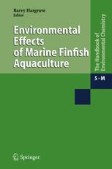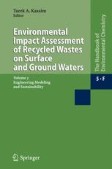Search
Search Results
-
Assessing Nitrogen Carrying Capacity for Blue Hill Bay, Maine: A Management Case History
As net-pen aquaculture in coastal waters grows, regulatory agencies must consider the potential for localized eutrophication. To avoid excessive...
-
Organic Chemicals in Groundwater: Modeling Fate and Transport
Hazardous organic chemical waste that has been placed in landfills or recycled for use as highway construction and repair materials has the potential...
-
Beneficial Reuses of Scrap Tires in Hydraulic Engineering
Scrap tires are a high-profile waste material. There are serious concerns over the ever-mounting scrap tire problem. A need exists for increasing...
-
Nonaqueous Phase Liquid Pool Dissolution in Subsurface Formations
The objective of this chapter is to present some recent developments on nonaqueous phase liquid (NAPL) pool dissolution in water saturated subsurface...
-
Mathematical Methods for Hydrologic Inversion: The Case of Pollution Source Identification
The reliable assessment of hazards or risks arising from groundwater contamination problems and the design of efficient and effective techniques to...
-
The Suitability of Electrode Measurements for Assessment of Benthic Organic Impact and Their use in a Management System for Marine Fish Farms
A management system for marine fish farms in Norway has recommended the use of simple electrode measurements of redox potentials (E...
-
The Tail of Two Rivers in Tasmania: The Derwent and Huon Estuaries
The Derwent and Huon Rivers are two relatively small river systems in the southeast of Tasmania (Australia). They terminate in estuaries that are...
-
The Sacca di Goro Lagoon and an Arm of the Po River
The Po di Volano canal–Sacca di Goro lagoon is a small hydrographic system partially located in the southern part of the Po River Delta. The total...
-
Present Status of Antifouling Systems in Japan: Tributyltin Substitutes in Japan
An international conference held by the International Maritime Organization in October 2001 adopted an “International convention on the control of...
-
Geochemistry of the Amazon Estuary
The Amazon River supplies more freshwater to the ocean than any other river in the world. This enormous volume of freshwater forces the estuarine...
-
New Trends in Sample Preparation Methods for the Determination of Organotin Compounds in Marine Matrices
Tributyltin still remains a major issue for the marine environment and its determination is mandatory by legislation in several countries. As for...
-
Development, Occurrence and Regulationof Antifouling Paint Biocides: Historical Review and Future Trends
Antifouling agents have been used on ships since the ancient Roman and Greek civilizations. A brief history is provided through to the demise of...
-
Role of Particle Sorption Properties in the Behavior and Speciation of Trace Metals in Macrotidal Estuaries: The Cadmium Example
The role of particles in the fate and speciation of trace metals in macrotidal estuaries was studied using a surface complexation model (MOCO)....
-
Antifouling Paint Booster Biocides: Occurrence and Partitioning in Water and Sediments
Following the ban on the use of tributyltin (TBT) in antifouling, several organic booster biocides have been used in conjunction with copper in...
-
Worldwide Occurrence of Organotins from Antifouling Paints and Effects in the Aquatic Environment
Organotins belong to the most toxic pollutants for aquatic life known so far. Widespread contamination of harbors and areas with high ship**...
-
Risk Evaluation of Dietary and Dermal Exposure to Musk Fragrances
Synthetic musk compounds comprising nitro musks, polycyclic musks and macrocyclic musks are used in fragrances which are added to a variety of...
-
Synthetic Musks in Bioindicators: Monitoring Data of Fish and Human Milk Samples from the Czech Republic
Until the middle of the 1990s, no attention was paid to the pollution of the environment in Czech Republic by synthetic musk fragrances and to the...
-
Synthetic Musks in Suspended Particulate Matter (SPM), Sediment, and Sewage Sludge
Nitro musk and polycyclic musk fragrances accumulate in solid matters of the aquatic environment. They are analyzed by extraction with an organic...
-
Enantioselective Analysis of Polycyclic Musks as a Versatile Tool for the Understanding of Environmental Processes
In this chapter the application of enantioselective chromatography to process studies related to the microbial, enzymatic and photochemical...
-
Biotic and Abiotic Transformation Pathways of Synthetic Musks in the Aquatic Environment
Synthetic musks are being transformed to intermediates or relatively stable metabolites that may exhibit a strong potential for environmental harm....
